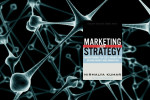Product Platform Strategy

Product strategy consists of three layers: strategic product vision, product platform strategy, product line strategy, and individual products.
Product Strategy for High Technology Companies by Michael E. McGrath
Product Strategy for High Technology Companies is a comprehensive guide to building your product strategy. McGrath begins with discussing vision, which must precede strategy. He discusses various types of vision, including “impaired”, “tunnel” and “shortsighted” vision symptoms. Once vision is established, it must be aligned with strategy in order to be effective.
The book includes discussions of product platform and product line strategy. McGrath includes outlines of value-chain and leveraged expansion path strategies. Although it was written in 2001 before many contemporary internet companies were founded, it still contains a wealth of product strategy discussion and process.
The beginning of McGrath’s book covers this pyramid of product vision, product platform strategy, and product line strategy. The remainder of the book has a chapter on each individual product strategy (differentiation, price-based, time-based, global, cannibalization, expansion, innovation) and closes with a discussion of the larger strategic planning process.
One section of the book is dedicated to competitive strategy and differentiation, including through lower cost, higher performance, design, standards, total solutions, and total cost of ownership. McGrath also identifies many pricing strategies and their consequences along with growth strategies (acquisitions and new ventures). The book concludes with a section on the product strategy process
Strategic product vision
The strategic vision focuses new product opportunity efforts, establishes the framework product platform strategy, provides direction for development activities, and sets expectations for customers, employees, and investors. The strategic vision answers three questions: Where?, How?, and Why? The first question specifies the nature of the opportunity; the second question describes how the company will get to its goals; and the third question identifies why the company is uniquely positioned to take advantage of the opportunity.
Written in 1995, Product Strategy for High Technology Companies remains a relevant and insightful book for product development leaders. You won’t find Google, YouTube, or facebook in the case studies, but the fundamentals of product strategy are all there.
Types of product vision
McGrath gives a summary of the various types of vision from “blind vision” through “shortsighted vision”, “tunnel vision”, and “vision as a mirage” to “peripheral vision” and “foresighted vision”. “Vision as a mirage” is characterized by the pursuit of markets that never materialize while “short-sighted” and “tunnel” vision are too focused on the near term and narrow opportunities. The spectrum spans the range of no strategic vision to seeing and taking advantage of opportunities of which others are not aware.
The key to developing a good product vision is to be specific enough to provide a definitive target, but not so limiting that only a single, narrow, opportunity can be exploited. Moreover, product vision cannot exist on its own. To be effective, it must translate into product strategy, especially defining the vector of differentiation.
The product vision example McGrath gives in the book is: “Our strategy is to provide computer-based tools for improving programmer productivity. These tools will take advantage of increasing computer power to provide ease of use.“
Product Platform Strategy
A product platform is not a product. It is a collection of the common elements, especially the underlying core technology, implemented across a range of products.

Product platform strategy sits between the product vision and product line strategy which guides individual product development. A product platform is not what is sold to customers. It is the foundation of product strategy because in high tech companies, many products are typically built from a core technology. Selection of core technologies used in product platform decisions are frequently irreversible and have long term impact for product development. Product platforms can also be a source of differentiation. McGrath gives several examples of differentiation resulting from platform design including versatility, fault tolerance, price performance, portability and integration of common functions. Proprietary or defensible platforms can also provide sustainable competitive advantage because they can support any number of derivative products and product lines.

Characteristics of product platform strategy include:
- defining product generations (not just individual products)
- supporting extension through periodic improvements
- ability to create derivative platforms (e.g., Mac Powerbook)
- creating opportunities for exploiting entirely new markets (“product platforms are essential, not incremental”)
McGrath notes that, like products, product platforms have life cycles and must go through planning processes similar to those of individual products. As the product platform is designed, the core technology is selected and the primary vector of differentiation is chosen.
Product Line Strategy
After creating the product platform strategy, the product-line strategy can proceed. A product line is built on a product platform and all product within the line use the platform as a foundation for development.
A product line is an integrated set of products with a similar, but somewhat different, purpose…The primary objective of product-line strategy is to cover the market by penetrating the appropriate market segments.
Product lines can be defined by several characteristics including: capacity, performance, features, packaging, or quality. Product-line strategy includes choices about which characteristics to incorporate into the products within the line.
Ingredients for a successful product-line strategy are: market segment coverage, focus, time-phased schedule, and coordination. Each product within the product line is intended to be focused on a specific market segment and they collectively should cover all major segments of the target market. McGrath gives Dell as an example with their Dimension (affordable home computer), Dimension XPS (for users who value high performance), OptiPlex (high-end corporate users), and NetPlex (price-sensitive corporate buyers) computers. He notes that without an effective product line strategy, criteria other than target market needs will dominate the definition of products within the lines. Product-lines can also enable focus by reducing product proliferation. Release timing of individual products within a product line is an important consideration–a product-line plan can be used as an overall plan to manage the timing of individual product releases. Likewise, product-line strategy should coordinate releases between each product-line to ensure priority market segments are being served.
Jumping ahead to product development without product platform and product-line strategy can result in backing into platform decisions. This creates a situation where the base technology is developed without a broader view of its applicability and extension.





